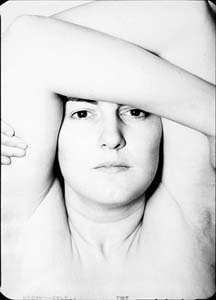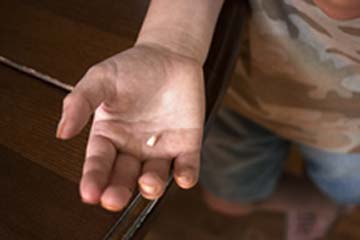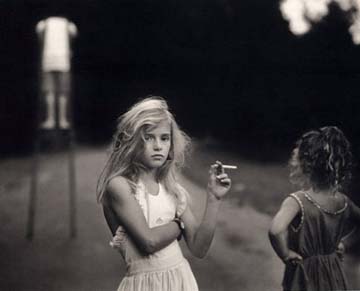Relative Closeness: Photographs of Family and Friends

About the Exhibition
Work by:
Harry Callahan
Jen Davis
Todd Deutsch
KayLynn Deveney
Deanna Dikeman
Ben Gest
Cynthia Greig and Richard H. Smith
Alice Hargrave
Vince Leo
Sally Mann
Hrvoje Slovenc
Aleksandra Vajd
These artists explore their immediate environments and the people who anchor them, as a way to reflect upon their own mortality.
Relative Closeness presents the work of artists who focus their cameras on their own friends, families, and homes. These artists explore their immediate environments and the people who anchor them, as a way to reflect upon their own mortality. Ranging from affectionate portraits to psychologically challenging images, these works investigate and often question universal ideas of the sweetness and sanctity of family life. Some of the artists probe the very meaning of “family,” others turn to friends, themselves, or even old family photographs to examine their need for human connection and sanctuary.
This exhibition showcases works from the Midwest Photographers Project and permanent collection of the Museum of Contemporary Photography at Columbia College Chicago. The permanent collection focuses on photography made since 1936. More than 8,000 photographs and photographically-related objects reflect the medium’s diverse capacities for artistic expression and documentation. An overriding emphasis is placed on the power of photography as art and idea.
An overriding emphasis is placed on the power of photography as art and idea.
The Midwest Photographers Project (MPP) is the museum’s rotating archive of works by artists living and working in the midwestern United States. Inaugurated in 1982, the MPP includes recent portfolios by prominent and emerging photographers from Illinois, Indiana, Iowa, Kansas, Michigan, Minnesota, Missouri, Ohio, and Wisconsin. Spanning a diverse array of media, subject matter, and style, MPP is a unique and expansive resource. It includes over 1,000 photographs by 75 photographers, with new portfolios introduced almost every month.
Highlights from Relative Closeness
KayLynn Deveney met her subject, Albert Hastings, in 2001 when she and her husband were living in Wales. Hastings was their neighbor, and Deveney noticed him outside his apartment watering his garden, going to the grocery store, and sometimes just watching the activity on the street. Deveney began photographing his daily routines and eventually had him respond to each picture by captioning the images she had pasted in a small notebook. She explains: “Each speaking from our own perspective, we began a dialog. Bert’s captions create a new context for my photographs, one that sometimes corresponds to the thinking that shaped the image and other times interprets the image in a different way.” Hastings passed away in February, 2007 at the age of ninety-one.
The video footage in Black Box: This is not my Father, by Cynthia Greig & Richard H. Smith, was taken on a boat trip Greig and her father took to the island of Culebra, Puerto Rico, in 1989. The following year, on a trip to Venezuela, her father died in a tragic plane crash. The audio in this piece is a reenactment of the last few minutes of dialog recorded by the airplane’s black box, read by actors from the original transcript. The video is two minutes long and the audio is three minutes long. Edited as a continuous loop, the relationship between the emotional, frantic audio and slow-moving, cheerful vacation footage changes with each pass, mirroring the unpredictability and cyclical nature of life.
In a very personal body of work, Jen Davis creates what she calls a “confrontation of self,” a series of self-portraits taken in her home that help her to see herself as the rest of the world does. As a large woman in a society that declares a beauty ideal of the thin, Davis uses photography to explore what it means to be considered an attractive female. Yet whatever discussion these pictures raise about women, beauty, or body image, they still concern a single, very personal story. The melancholy of Davis’s pictures suggests that her home, while perhaps a refuge from the vulnerability of being seen, is also a place of loneliness and anxiety in which photography helps to fill an emotional void.
Hrvoje Slovenc takes pictures of same-sex couples who have been together for an average of eighteen years. Inspired by late nineteenth-century wedding portraits, Slovenc arranges his couples as if they were appearing on their wedding day, something that remains a legal impossibility in this country. “The couples appear to be both physically and emotionally disconnected because in many ways, both subtle and overt, that is how they are told they should behave,” Slovenc explains.
To create the images in her series Home (movies), Alice Hargrave digitally captures frames from her family’s 8mm vacation films that had been transferred to video. In subjecting her chosen clips to several modes of transformation, from film to video, and video to the screen lines of a monitor, she creates a sense of temporal and psychological distance between the original scene and its printed image. Hargrave’s process of distilling these images suggests the effects of time on memory. As she breaks down and translates these personal moments, they become increasingly hazy and anonymous.
Image Gallery


